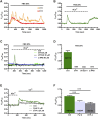Nicotinic Acid Adenine Dinucleotide Phosphate Induces Intracellular Ca2+ Signalling and Stimulates Proliferation in Human Cardiac Mesenchymal Stromal Cells
- PMID: 35392169
- PMCID: PMC8980055
- DOI: 10.3389/fcell.2022.874043
Nicotinic Acid Adenine Dinucleotide Phosphate Induces Intracellular Ca2+ Signalling and Stimulates Proliferation in Human Cardiac Mesenchymal Stromal Cells
Abstract
Nicotinic acid adenine dinucleotide phosphate (NAADP) is a newly discovered second messenger that gates two pore channels 1 (TPC1) and 2 (TPC2) to elicit endo-lysosomal (EL) Ca2+ release. NAADP-induced lysosomal Ca2+ release may be amplified by the endoplasmic reticulum (ER) through the Ca2+-induced Ca2+ release (CICR) mechanism. NAADP-induced intracellular Ca2+ signals were shown to modulate a growing number of functions in the cardiovascular system, but their occurrence and role in cardiac mesenchymal stromal cells (C-MSCs) is still unknown. Herein, we found that exogenous delivery of NAADP-AM induced a robust Ca2+ signal that was abolished by disrupting the lysosomal Ca2+ store with Gly-Phe β-naphthylamide, nigericin, and bafilomycin A1, and blocking TPC1 and TPC2, that are both expressed at protein level in C-MSCs. Furthermore, NAADP-induced EL Ca2+ release resulted in the Ca2+-dependent recruitment of ER-embedded InsP3Rs and SOCE activation. Transmission electron microscopy revealed clearly visible membrane contact sites between lysosome and ER membranes, which are predicted to provide the sub-cellular framework for lysosomal Ca2+ to recruit ER-embedded InsP3Rs through CICR. NAADP-induced EL Ca2+ mobilization via EL TPC was found to trigger the intracellular Ca2+ signals whereby Fetal Bovine Serum (FBS) induces C-MSC proliferation. Furthermore, NAADP-evoked Ca2+ release was required to mediate FBS-induced extracellular signal-regulated kinase (ERK), but not Akt, phosphorylation in C-MSCs. These finding support the notion that NAADP-induced TPC activation could be targeted to boost proliferation in C-MSCs and pave the way for future studies assessing whether aberrant NAADP signaling in C-MSCs could be involved in cardiac disorders.
Keywords: cardiac mesenchymal stem cells; membrane contact sites; nicotinic acid adenine dinucleotide phosphate (NAADP); proliferation; store operated Ca2+ entry; two-pore channels (TPCs).
Copyright © 2022 Faris, Casali, Negri, Iengo, Biggiogera, Maione and Moccia.
Conflict of interest statement
The authors declare that the research was conducted in the absence of any commercial or financial relationships that could be construed as a potential conflict of interest.
Figures








Similar articles
-
Nicotinic Acid Adenine Dinucleotide Phosphate (NAADP) Induces Intracellular Ca2+ Release through the Two-Pore Channel TPC1 in Metastatic Colorectal Cancer Cells.Cancers (Basel). 2019 Apr 15;11(4):542. doi: 10.3390/cancers11040542. Cancers (Basel). 2019. PMID: 30991693 Free PMC article.
-
Nicotinic acid adenine dinucleotide phosphate activates two-pore channel TPC1 to mediate lysosomal Ca2+ release in endothelial colony-forming cells.J Cell Physiol. 2021 Jan;236(1):688-705. doi: 10.1002/jcp.29896. Epub 2020 Jun 24. J Cell Physiol. 2021. PMID: 32583526
-
NAADP mobilizes calcium from acidic organelles through two-pore channels.Nature. 2009 May 28;459(7246):596-600. doi: 10.1038/nature08030. Epub 2009 Apr 22. Nature. 2009. PMID: 19387438 Free PMC article.
-
Calcium signaling via two-pore channels: local or global, that is the question.Am J Physiol Cell Physiol. 2010 Mar;298(3):C430-41. doi: 10.1152/ajpcell.00475.2009. Epub 2009 Dec 16. Am J Physiol Cell Physiol. 2010. PMID: 20018950 Free PMC article. Review.
-
Modulation of Calcium Entry by the Endo-lysosomal System.Adv Exp Med Biol. 2016;898:423-47. doi: 10.1007/978-3-319-26974-0_18. Adv Exp Med Biol. 2016. PMID: 27161239 Review.
Cited by
-
TRPML1-Induced Lysosomal Ca2+ Signals Activate AQP2 Translocation and Water Flux in Renal Collecting Duct Cells.Int J Mol Sci. 2023 Jan 13;24(2):1647. doi: 10.3390/ijms24021647. Int J Mol Sci. 2023. PMID: 36675161 Free PMC article.
-
Metabolites of Life: Phosphate.Metabolites. 2023 Jul 19;13(7):860. doi: 10.3390/metabo13070860. Metabolites. 2023. PMID: 37512567 Free PMC article. Review.
-
Pathological Functions of Lysosomal Ion Channels in the Central Nervous System.Int J Mol Sci. 2024 Jun 14;25(12):6565. doi: 10.3390/ijms25126565. Int J Mol Sci. 2024. PMID: 38928271 Free PMC article. Review.
-
Lysosomal TRPML1 triggers global Ca2+ signals and nitric oxide release in human cerebrovascular endothelial cells.Front Physiol. 2024 Jun 21;15:1426783. doi: 10.3389/fphys.2024.1426783. eCollection 2024. Front Physiol. 2024. PMID: 38974517 Free PMC article.
-
Two-pore channels: going with the flows.Biochem Soc Trans. 2022 Aug 31;50(4):1143-1155. doi: 10.1042/BST20220229. Biochem Soc Trans. 2022. PMID: 35959977 Free PMC article.
References
-
- Balducci V., Faris P., Balbi C., Costa A., Negri S., Rosti V., et al. (2021). The Human Amniotic Fluid Stem Cell Secretome Triggers Intracellular Ca2+ Oscillations, NF‐κB Nuclear Translocation and Tube Formation in Human Endothelial colony‐forming Cells. J. Cel Mol Med 25, 8074–8086. 10.1111/jcmm.16739 - DOI - PMC - PubMed
LinkOut - more resources
Full Text Sources
Miscellaneous

